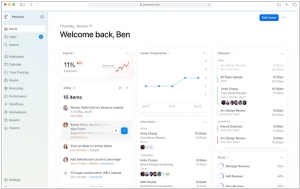AWS Outposts vs Nutanix
October 14, 2024 | Author: Michael Stromann
4★
Run AWS infrastructure and services on premises for a truly consistent hybrid experience
9★
The industry’s most popular hyperconverged infrastructure (HCI) solution. Effortlessly leverage cloud-like agility and ease of use, coupled with on-premises security and control, as you leave behind the complexity and cost of legacy solutions.
Imagine, if you will, two peculiar contraptions that claim to bring the ethereal magic of the cloud—vast, mysterious and often misunderstood—down to the decidedly less glamorous locale of your local server room. First up, there’s AWS Outposts, a sort of glorified box of cloud goodness delivered by Amazon. It sits in your data center, humming contentedly and pretends it’s still part of the vast AWS empire. In essence, it’s as if Amazon has said, “Don’t worry, we’ll bring the cloud to you, so you won’t miss out on all the fun of compute, storage and AI, while still enjoying the joy of walking past your servers each day.” Think of it as the cloud that refuses to leave home.
Now, Nutanix, on the other hand, is like a DIY cloud kit with a bit more personality. It rolls up its sleeves and says, “Forget about calling Amazon; we’ve got this.” Nutanix bundles compute, storage and networking into one neat package, throws in its own hypervisor for good measure and essentially builds a private cloud fortress wherever you please. It’s all about simplicity and flexibility—because who doesn’t love combining virtualized everything into one tidy stack? You get to manage it all with Nutanix's own set of tools, which are delightfully less prone to asking, “Have you tried turning it off and on again?”
In the grand cosmic scheme of things, AWS Outposts is for those who’ve pledged eternal allegiance to Amazon’s vast, sprawling ecosystem, happily plugging into all things AWS. Nutanix, however, is the plucky underdog, offering its own flavor of on-premises cloud with a wink and a nudge, ideal for those who like to roll their own but still enjoy the occasional bit of wizardry. Both have their charms, but as with anything involving clouds, it’s all a matter of which way the wind blows.
See also: Top 10 Private Cloud platforms
Now, Nutanix, on the other hand, is like a DIY cloud kit with a bit more personality. It rolls up its sleeves and says, “Forget about calling Amazon; we’ve got this.” Nutanix bundles compute, storage and networking into one neat package, throws in its own hypervisor for good measure and essentially builds a private cloud fortress wherever you please. It’s all about simplicity and flexibility—because who doesn’t love combining virtualized everything into one tidy stack? You get to manage it all with Nutanix's own set of tools, which are delightfully less prone to asking, “Have you tried turning it off and on again?”
In the grand cosmic scheme of things, AWS Outposts is for those who’ve pledged eternal allegiance to Amazon’s vast, sprawling ecosystem, happily plugging into all things AWS. Nutanix, however, is the plucky underdog, offering its own flavor of on-premises cloud with a wink and a nudge, ideal for those who like to roll their own but still enjoy the occasional bit of wizardry. Both have their charms, but as with anything involving clouds, it’s all a matter of which way the wind blows.
See also: Top 10 Private Cloud platforms





